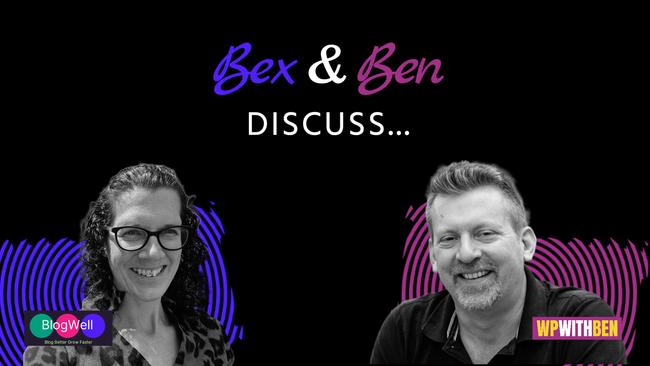Why You Should Never Use AI To Write Your Blog Posts
I know how tempting it is to use AI to write your blog posts. I mean come on, it’s super quick, it has an endless supply of ideas, and well it just makes life so much easier.
Plus, everyone’s using it these days, surely no one’s going to be able to tell. And if it’s a case of you sharing blog posts v’s not sharing any, then it’s a no brainer, right?
There’s no denying that AI tools, like ChatGPT, can make blogging easier. It’s a powerful beast that’s not going away. And you’d think that content creators and bloggers like me would be quaking in our boots, worried we’ll be made redundant, our services no longer needed. After all, how can we possibly compete with the robots!?!
Yes, AI is powerful, but it isn’t and never will be, human. And whilst I do think it is a very valuable tool to have in your blogging arsenal, I don’t think you should ever use AI to write your blog posts.
I’m going to explain why you shouldn’t rely on AI to write your blog posts, reveal the tell tale signs of AI generated content, give you an example of AI v’s human created content so that you can see the differences with your own eyes, and I’m going to finish up by sharing the ways that you can and should be using AI in your blog posts.
The Problem With AI-Generated Blog Posts
OK so why is it such a problem to use AI to write your blog posts? Well, there’s quite a few problems actually. Firstly, it isn’t great for SEO. There’s a very real risk with AI that the content it produces for you is duplicate copy that has also been produced for someone else. Highly unlikely that it’s going to be an exact word-for-word copy, but it could be similar enough for Google to think, hold on a moment I’ve seen this somewhere before. And Google really doesn’t like duplicate copy.
Google regularly updates its algorithms. These algorithms check for things like duplicate copy, copy that doesn’t go into greater depth, that’s not seen as useful, and that appears spammy. And based on those checks, it then determines how to rank your site. AI content pretty much falls into all those categories, which means if you’re sharing content that has been written by AI on your blog, you will almost certainly be penalised for it.
So, it’s a big deal.
But for me, the biggest problem of using AI-generated content on your blog, is that it’s fake. You’re basically lying to your audience. You’re not showing up as you. You’re hiding behind the cover of a robot, to create a very inauthentic version of your business. And that’s just wrong.
How can you expect your audience to connect with you, to get to know you, to believe in your expertise, and to trust you enough to reach a point where they feel comfortable working with you or buying from you, if you’re not being honest with them?
The Tell-Tale Signs Of AI-Generated Content
As someone who spends their days reading and writing content, I am particularly eagle-eyed when it comes to spotting content that has been writtten by AI. But I totally get that you might not be able to recognise it quite so easily. To be fair, it’s bloody good, and unless you know what you’re looking for it might not be immediately obvious.
The thing is, the search engines can spot it, and many business owners and content creators have experienced a massive drop in their rankings because of the fact they’re sharing AI content.
Plus, although your readers might not realise straightaway, they’ll definitely sense there’s something off with it and will struggle to connect with you in the same way as if you’d written the content yourself.
To help you spot AI generated content and to fully understand why content written by AI is so predictable and so apathetic, these are some of the tell-tale signs to look out for:
-
Clichés -Some classic AI cliches include: ‘let’s dive in’, ‘at the end of the day’, ‘it’s no secret that’, ‘the truth is’, ‘let that sink in’. Spot these phrases in a blog post and it’s almost certainly been written by AI.
- Excessive use of Emojis – I see content absolutely riddled with emojis these days. Don’t get me wrong, they have their place and they’re useful for drawing attention and making a point. But content that is literally littered with the things in a very structured and formulaic way is not natural.
- Long Dashes – Ever seen an ’em’ dash in a blog post? It’s this long line — and ChatGPT absolutely loves it. It bungs them everywhere, for no real reason, and it’s a big giveaway that the content has been written by a robot.
- Overuse of Transitional Phrases – Words like ‘moreover’, ‘additonally’, and ‘in conclusion’ are a surefire sign of AI content. They can be massively overused and makes the content seem stiff and too formal. You’re not writing an essay, you’re writing content that resonates with your readers and reflects you.
- Lack of Personal Experience – AI isn’t real. It hasn’t experienced real-life events. It doesn’t have real-life stories to share. It hasn’t lived. Therefore, AI content will never share first hand examples, honest confessions, or strong opinions.
- Formal/Generic Tone – If the content sounds like it’s been written by a robot, it usually has been. AI content lacks the quirky, stylistic, unique tone that humans use naturally in their writing. There’s an impersonal, blandness to the writing that can sound formulaic. It gets the point across, but without heart.
Learn More About Blogging On Our YouTube Channel
Why Human Writing Is Better Than Anything AI Can Create
When it comes to writing blog posts for your business, your voice is the most powerful tool you possess. Now I get that writing doesn’t come naturally to everyone. And it can take a while before you discover and develop your own unique blog voice and writing style.
But that’s all part of it. The experimentation, the vulnerability, the imperfection, that’s what makes your blog posts more relatable. That’s what connects you to your audience. AI can’t do that. It can inform. It can give the facts. But it can’t add emotional nuance. That’s what’s missing.
Human vs. AI Content Creation – The Proof!
It’s all well and good me telling you that you shouldn’t use AI in your blog posts, but until you’ve seen actual solid proof, well I’m not being funny, but why should you take my word for it?
We need proof, and that’s what I’m going to give you.
Below you’ll see a piece of content I wrote and shared on my Facebook page last week. Now, I’ve purposefully chosen this particular post because it’s a good example of very heartfelt, honest, and human writing. The fact that this is a social media post and not a blog post doesn’t actually matter. This is about showing you the difference between human written content and AI generated content.
I didn’t want to ask ChatGPT to rewrite my content, as that would be giving it too much of me, and the fact is if you’re using AI to write your content you wouldn’t write a whole post yourself first – that would be hugely counterproductive. Instead I gave it a prompt, based on the key areas I wanted covered in the post.
For fun, I also shared my original photo and asked it to recreate it’s own version.
Let’s compare the two:
Human Content
I’ve cried sooooooo much this week
My therapy session was tough.
Every week is different. Sometimes I’m strong, resilient, can talk calmly and rationally. Other times it can take just 1 word and WHAM the flood gates burst wide open.
And I never go there thinking this week’s going to be a hard one, but when that tidal wave of emotion hits and the tears come, I know we’ve got to the THING. The thing that matters, the root of what lies inside, the fear, the dread, the vulnerability that I mask and try to keep hidden away. Because society tells us we should have our shit together, that we should put on a front, wear that stuff upper lip, that we shouldn’t feel our feelings – not if they’re the heavy deep ones anyways. That it’s shameful and embarrassing to be so open. To be real. To reveal the raw.
But when I started crying during a visualisation exercise with the accountability group I’m part of, stuff started to make sense.
I sat with my eyes closed imagining where I saw myself in 5 years time.
- Where was I?
- What was I doing?
- How did I feel?
And I immediately started crying.
Because I have no grand dreams of earning millions, of being on a tropical beach somewhere far away, or of being famous and in the spotlight. My wants and needs are far simpler than that.
I saw myself here, sat on this tree seat in my forest garden.
Just me, doing what I love, having time for myself and my family.
All I really want is peace.
Perhaps all I’ve ever really wanted has been staring at me in the face all along. But I’ve struggled to see it because I’ve been too distracted by what I think other people expect of me. Clouded by the fear of judgement. Paralysed by shame, inferiority, and worthlessness.
I’ve cried so much this week because the reality is it’s not good to keep stuff bottled up. It will at some point come out, and only when it does can we work through the hard stuff and heal from within
So if you’ve cried this week too, just know you’re not alone.
Tears don’t mean weakness. They mean truth.They mean healing. They mean you’re finally listening to what’s really going on inside.
And maybe, just maybe…
That’s where we find our peace.

AI Content
🚨 VULNERABLE POST ALERT 🚨
This week, I cried. A lot. 😢
Not just once. Not just twice. But pretty much every day. Between therapy sessions that unearthed some deep-rooted emotional blocks and an unexpected moment in an online accountability group, the tears were flowing. 🧠💔
We did a visualisation exercise and were asked to imagine our lives in 5 years. I closed my eyes and suddenly, bam, there it was: a vision so clear it cracked me wide open. I saw myself sitting peacefully on the tree seat in my garden. Just being. No pressure. No hustle. Just… peace. 🌳✨
And the tears came.
Because sometimes — you don’t realise how badly you want something until you see it.
Here’s the thing — crying doesn’t mean you’re weak — crying means you’re brave enough to feel. To go there. To let it out instead of bottling it up. 💪💦
💡 Remember: Strength isn’t about holding it together. It’s about being real, even when it’s messy. 💡
👇 If you’ve ever cried your way to a breakthrough, drop a 💧 in the comments. Let’s normalise emotional honesty in business and life.
#VulnerableShare #MentalHealthAwareness #HealingJourney #FiveYearVision #StrongNotSilent

Human V’s AI Content
To give you a bit more context, here’s the prompt I gave Chat GPT:
“Please can you create a Facebook post for me. Tell a story about how much I have cried this week. Therapy has been tough and I’m dealing with some issues. Which also came to a head during a visualisation exercise in an online accountability group I’m in. We were asked to close our eyes and imagine where we saw ourselves in 5 year’s time and what did we want. I started crying. But I saw myself at home, sat in the garden on my tree seat, feeling peaceful. The main message should be that crying shows strength not weakness. Could you include a CTA.”
The difference between the two is vast. And let’s not even start on that photo! At a fleeting glance it looks like me, but it’s also totally not me. And that’s exactly how AI works – it gives the illusion, creates an impression, a hint at you, but it isn’t you and doesn’t sound or look like you.
Taking into account all the tell tale signs I told you about earlier, just look at how riddled with them the AI content is. We’ve got emoji overload, hashtags, unnecessary use of itallics, em dashes — , and cliched phrases (‘here’s the thing’, ‘drop a x in the comments’, ‘remember:, if you’ve ever’).
But aside from that, there’s no sense of the personal in there. No storytelling. No deep human emotions. Because the fact is it doesn’t know my full story. It doesn’t know how I felt. Only I can truly articulate that. And that, that right there, is where connections between you, your posts and your audience are made. AI simply cannot do that in the same way.
How AI Can Help With Blogging
OK so it probably feels like I’m very much team anti-AI, to the extent you’re probably now thinking that you should avoid it altogether. But I’m actually going to big it up for a bit, because AI can be a really valuable tool for you to use in your content marketing strategy. You just need to know how to use it properly!
I’m sure you’ve got it by now, but in case you’ve missed the memo I’ll make it loud and clear…
DO NOT USE AI TO WRITE YOUR BLOG POSTS!
It’s not big, it’s not clever, just don’t do it.
Here’s how you should be using it:
- Brainstorming – AI is great for generating content ideas and for brainstorming blog topics and titles.
- Structuring – I use ChatGPT to suggest subheading ideas and to create an overall outline of the points I need to feature in the post.
- Optimising – You can ask it to help with some basic SEO by suggesting keywords, making your title fit into an ideal character count, and writing a meta description for your post.
- Rewriting – If you’re struggling with an awkward sentance or feeling a lack of flow in your writing, you can use AI to rewrite or fine tune small sections.
- Editing – Use it to check your spelling and grammar, or to reduce the word count if you’re concerned you’re waffling too much.
How To Use AI Without Losing ‘You’
So, how do you use AI without losing that very real sense of you in your posts? It’s all about striking a balance and remembering that AI isn’t the star of the show (that’s you – in case you hadn’t realised by now!). Use it to help you with your content, but don’t let it overshadow you and steal all the limelight.
Nothing compares to the unique experience of human creativity. And if you want your audience to get to know you then it’s up to you to give them what they want… YOU!
Instead of using AI to write your blog posts:
- Write your first draft yourself and then ask AI to refine it.
- Make sure you edit everything that AI produces for you, to ensure your tone, voice, and style comes through in the writing.
- Only use prompts that align with your style and your values – mixed messaging can be confusing for your readers.
- Create a personal writing style guide that you can use to check your content against to make sure you’re not drifting away from the human approach.
Final Thoughts – Why You Should Never Use AI To Write Your Blog Posts
AI isn’t going anywhere and you’d be a fool not to use it in some way in your business. But there is a right way and a wrong way to use it. And when it comes to content creation you should never use AI to write your blog posts.
It may seem like a solution, a short cut, a path to consistent blog writing, but the reality is it’s serving you absolutely no favours. It won’t help you get more visible online and it won’t help you grow an audience of engaged and loyal followers.
Authentic, human led writing is the thing that connects. It’s what makes an impact. It’s what makes you stand out. It’s what people remember.
Use AI to support you, not speak for you. Because when it comes to blogging, your words are the only ones that matter.
Are you looking to build a smart content marketing strategy using blogging and social media?
Join the BlogWell Facebook Group
Author Bio
Bex Stafferton is a blogger who started off writing her blog The Art of Healthy Living as a hobby when she was a stay at home mum and caring for her two young children. The same blog now earns her a full time salary while working part time hours.
Bex is on a mission to help teach businesses how having a blog on their website is a valuable marketing tool. Helping to build a strong online presence, grow an engaged audience, and increase sales.
When she’s not blogging, Bex spends her time hiking up mountains, trail running, cuddling her two cockapoos, and volunteering at a local wildlife rescue centre.











One Comment